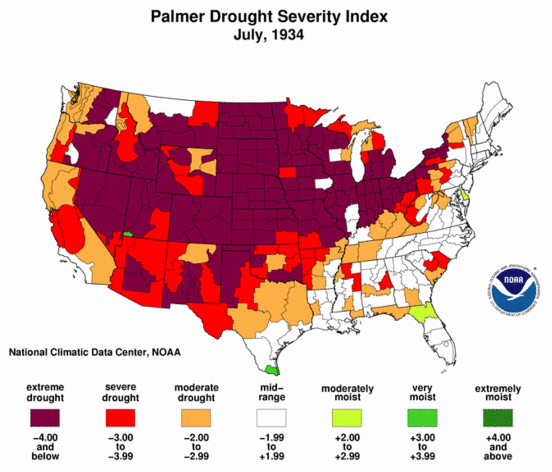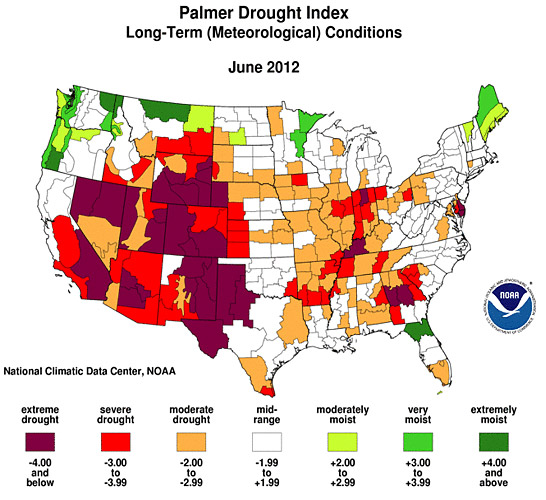Last week, when Chicago almost hit the highest recorded temperature in its history last week, it was going up against a high set in 1934—which, as I mentioned at the time, was one of many, many hot days that decade, which saw a still-unprecedented number of heat waves. That history of '30s heat waves, which brought America the Dust Bowl, came up frequently as highs were set or approached across the country. The Washington Post's excellent weather blog rounded up how that spate of hot summers, as well as those in the 1950s, was brought up as a challenge to the idea that climate change had anything to do with last week's temperatures:
Take Washington Post columnist George Will, who was completely underwhelmed by the recent spell of sweltering temperatures.
“How do we explain the heat? One word: summer,” he said on ABC News’ This Week Sunday morning.
I mention this because I take some interest in weather, and whenever there's weird weather (and there's always weird weather) it's always seized on as evidence that climate change is responsible or evidence that climate change doesn't exist. Neither's a particularly good way to think about it, and the Dust Bowl summers, including the one that set Chicago's still-record high, are a good example of that. For reference, here's the Dust Bowl drought compared to current drought conditions:


In 2004, NASA scientists took a deep dive into ship records from the 1930s, using sea-surface temperature records to create a climate model, and found evidence of the Dust Bowl's origins in the oceans:
The study found cooler than normal tropical Pacific Ocean surface temperatures combined with warmer tropical Atlantic Ocean temperatures to create conditions in the atmosphere that turned America's breadbasket into a dust bowl from 1931 to 1939. The team's data is in this week's Science magazine. These changes in sea surface temperatures created shifts in the large-scale weather patterns and low level winds that reduced the normal supply of moisture from the Gulf of Mexico and inhibited rainfall throughout the Great Plains.
Five years later, NOAA researchers challenged the claim, while attributing 1950s droughts to such oceanic conditions:
New work by meteorologist Martin Hoerling and colleagues at NOAA's Earth System Research Lab in Boulder, CO, shows that the 1950s drought in the southern plains was linked — as expected — to cool ocean surface temperatures in the eastern equatorial Pacific — a series of La Niña episodes.
But the 1930s drought centered in the northern plains was linked to random variability in the atmosphere — a result that conflicts with earlier work. Hoerling said his more detailed analysis did not support "the prior speculation that the Dust Bowl drought had early warning indicators in the ocean temperatures." The new study, published in the journal Geophysical Research Letters, supports other work that pointed to "dust aerosol feedbacks" between low soil moisture and farming practices in the 1930s that left the soil exposed to windstorms.
Which is to say that the Dust Bowl, given weather patterns and statistical inputs, was singular: "The inability to correctly model the spatial pattern of the Dust Bowl drought, and its deviation from the typical pattern of tropical SST-forced drought, makes us wonder how unusual the Dust Bowl pattern was. Analyses of instrumental data since the mid nineteenth century – shows that none of the other five multiyear droughts in this interval (1856-65, 1870-77, 1890-96, 1948-57 and post 1998) had a similar pattern."
So, what? That's where scientists start looking towards manmade climate change. On a much, much smaller scale than global warming, but the concept is the same—patterns of development and technological change that interacted with naturally occurring weather patterns to create unpredictable results:
The modeled drought with just SST [sea surface temperature] forcing is clearly centered too far to the Southwest. With the addition of interactive dust the drought not only intensifies but also moves further to the north, more in line with the observed pattern. Dust intensifies the drought because of a reduction of surface solar radiation by dust loading in the atmosphere which reduces the energy available for surface evaporation. The drought moves northward because of the pattern of dust transport in the southwesterly flow….
[snip]
These first cut modeling experiments suggest that the Dust Bowl disaster was the result of complex interactions between humans and the environment. First changes in tropical sea surface temperatures created a drought. Poor land use practices then led to exposure of bare soil followed by wind erosion and dust storms. The dust storms interacted with radiation to make the drought worse and move it northward increasing the potential for further wind erosion. That said, even without the human role, the drought would have occurred and the human impact was limited. However the actual dust loss in the 1930s is poorly constrained and we have also ignored so far the potential impact on climate and hydrology, through the surface radiation and moisture balances, of the vegetation loss itself.
Awhile back I tried to explain to someone that the best way to think about global warming and climate change is like steroids in baseball. Steroids don't make players hit home runs in every at bat; they don't even make some players good (see recent the recent PED suspension of Marlon Byrd). In the absence of PEDs, there will still be home runs and 20-run games. But if a lot of players take steroids, then there will be more fit, strong players, and those will increase—you can't specifically attribute one instance to PEDs, but you can start to attribute likelihood.
If you don't like that metaphor, try James Hansen's: loaded dice.
“Climate dice,” describing the chance of unusually warm or cool seasons relative to climatology, have become progressively “loaded” in the past 30 years, coincident with rapid global warming. The distribution of seasonal mean temperature anomalies has shifted toward higher temperatures and the range of anomalies has increased…. It follows that we can state, with a high degree of confidence, that extreme anomalies such as those in Texas and Oklahoma in 2011 and Moscow in 2010 were a consequence of global warming, because their likelihood in the absence of global warming was exceedingly small.
This is what scientists have been trying to figure out with the Dust Bowl. There would have been a drought anyway; there have been droughts that were very much like it but worse during the Medieval Climate Anomaly (PDF); but in the absence of man-made climate change, it's implausible that a drought like the Dust Bowl would have occurred when it did, where it did without the farming methods of the 1920s.
That's kind of the direction the discourse about climate change is going. Again, from the WaPo's awesome weather blog, a conversation with NOAA research meteorologist Martin Hoering:
Sometimes you’ll see ‘that heat wave was due to climate change’ That’s not a very accurate statement, not a very helpful statement. But it’s not entirely untrue either.
[snip]
It may well be that 90 percent of [a given] heat wave was natural, but that the 10 percent that pushed it to record proportions was due to climate change.
[snip]
[Presently] we’re breaking high temperature records much more frequently than by chance. And, by some estimates, the ratio of that exceedance of breaking highs compared to what you would expect by chance would lead to us say to that there’s about an 80 percent chance that the record high you experienced was due to climate change.
It's not a satisfyingly black and white answer, but at least we're starting to get a sense of the grayscale.



